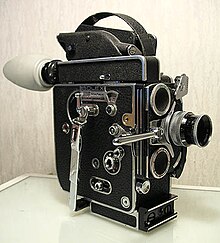C-mount

The C-Mount is a standardized threaded connection for (moving image) camera lenses in the professional field. The outside diameter of the thread is 1 inch (2.54 cm), the thread pitch is 1 ⁄ 32 inch. The flange focal length between the flange of the lens thread and the image plane corresponds to 17.526 mm (0.69 inches) or 12.5 mm for the CS mount . The C-Mount is standardized by SMPTE with the standard SMPTE 76-1996 and is also referred to as "1-32 UN 2A" according to the ANSI B1.1 thread standard .
As a rule, C-mount lenses have manual focus and manual aperture setting (film jargon: iris); However, there are also lenses with motorized focus and aperture control.

In cine film technology (reportage cameras ) and later in video technology , the C-mount is a widespread standard. The lens mount was introduced by Bell & Howell in the 1920s with the Filmo 70 , a 16mm narrow film camera. The C-mount standard is still used today in cine film and video technology: Currently (June 2015) at least the companies Bolex and Logmar are offering film cameras with C-mount. At least one current video camera is also supplied with a C-mount. Since there has not been a camera system with a C-mount that is manufactured in large series for years, the use of surveillance and industrial cameras has been concentrated. Since the introduction of small digital system cameras such as Micro Four Thirds or Sony NEX-5 , C-mount lenses with suitable adapters have also been used on these cameras. Kenko announced a compact system camera for use with C-mount lenses in February 2011. It is unclear whether this camera was also available on the market, as the company merged with Tokina a short time later and nothing about this product can be found on the website.
In contrast to film technology, thread connections were previously replaced by bayonet connections in general photography, since changing lenses by unscrewing and screwing on was felt to be too time-consuming and laborious. To make a quick lens change possible, several of the relatively small lenses with C-mount connection and fixed focal length were first mounted in revolvers or slide changers. As soon as zoom lenses of sufficient quality were available, they were used. For the small formats of the film cameras, zoom lenses of sufficient quality were available much earlier than for the much larger formats. By keeping the C-mount, you can choose between small, light and inexpensive zoom lenses and large, heavy, high-speed zoom lenses with a large focal length range. Special lenses with a fixed focal length, extension extensions for close-ups, microscopes and telescopes can also be connected. As a thread, the C-Mount can also transmit much greater forces than a bayonet of the same size. In contrast to other cameras, film cameras or the mounting plate carrying them are always mounted directly on the tripod head in order to be able to swivel. The lens connection must therefore be able to carry very heavy lenses. In 35mm photography, on the other hand, a heavy lens is attached directly to the tripod, and the lens carries the relatively much lighter camera. Some professional film cameras like Eclair and Bolex, which introduced manufacturer-specific bayonets, were given C-mount adapters in order to be able to use existing special lenses.
C-mount lenses are available with different image circles for different sensor / film sizes such as 1 ⁄ 2 ″, 2 ⁄ 3 ″, 1 ″, 8 mm, Super 8 / Single 8 and 16mm / Super 16 . When a lens with a small image circle is connected to a camera with a larger image window, vignetting can occur, while conversely, a crop factor must be taken into account when determining an image angle .
In microscopy, the C-mount is used to connect digital cameras. A special connection is often provided on the microscope here, which in modern models does not require any further enlargement or reduction using eyepieces or projectives, which are still required with older microscopes. The image generated by the microscope lens is large enough to fully illuminate the sensors, which are much smaller than conventional film formats. The subsequent enlargement is done by displaying the small sensor image on the large screen. The other way around: the camera connected via C-mount shows only part of the image seen through the eyepieces.
A C-mount lens can be connected to a CS-mount camera with an intermediate ring of around 5 mm length.
Individual evidence
- ↑ Qioptiq Q-Shop | Precision optics, optomechanics, instruments. Retrieved June 19, 2020 .
- ↑ http://www.c-mountlens.com/2011/c-mount-lens-history/
- ↑ http://bolex.ch/NEW/?p=2
- ↑ Archived copy ( memento of the original from October 4, 2017 in the Internet Archive ) Info: The archive link was inserted automatically and has not yet been checked. Please check the original and archive link according to the instructions and then remove this notice.
- ↑ http://www.digitalbolex.com/shop/d16-cinema-camera/
- ↑ Kenko C-Mount Camera System | Photography blog. Retrieved June 19, 2020 (English).
- ↑ http://www.kenko-tokina.co.jp/
